04 February 2006
Ur
During a delay on a recent mission, I was able to visit the ancient city of Ur. It is located just outside of the city of Nasiriyah. What a neat place. Other than it being the birthplace of Abraham (revered as a patriarch in the Bible, Torah and Koran) and the starting point of his migration westward to Palestine in about 1900 B.C., I really didn’t know much about the city . But, the tour guide there, Muhsen, gave us an informative, close up tour of this amazing place.
The most visible dwelling in the area is the Ziggurat. It stands about 70 feet tall. Here are pictures of the Ziggurat from afar and one with me running up its steps:
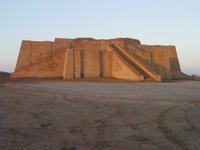


The Ziggurat was built around 2100 B.C. One thing that I found interesting was that the structure itself is solid. That is, it has no rooms or open areas inside. According to Muhsen, the Ziggurat was built by the Sumerians as a way in which to be closer go the god of the moon. The moon god was suppose to come from the sky and walk down the steps of the Ziggurat to be with the people. The Ziggurat itself was uncovered in the mid-1800's by the British. Apparently, there was at least one more level above the current Ziggurat structure that didn't survive the excavation.
Most of the structures at the city of Ur site are original. Muhsen said that the bricks in the public buildings (like the Ziggurat) are held together with a natural tar-like substance. Because the substance was so expensive back then, private buildings (such as dwellings) often used instead a mud-based substance to hold the bricks together. Here’s a picture of Muhsen explaining some of the details about how the buildings were made:
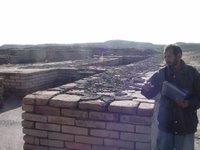
Below are several things “of note” at the site that I thought were fascinating:
*The site had many examples of ancient cuneiform writing, which according to Muhsen predates hieroglyphics. Here’s a sample:

*Small sea shells from one of the two floods (estimated to have occurred around 4000 B.C. and 2900 B.C.) were all over the place. It was strange to see small sea shells not on the sea shore but on the desert floor instead. :-)
*There were several tombs of kings in which 50 or so servants were buried alive (apparently voluntarily). Here are a number of pictures.

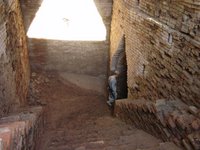
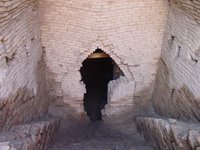

Compare those pictures of tombs with a picture of a tomb of a “common” person, not much higher than mid-thigh:

*The world’s first arch according Muhsen (or perhaps oldest intact?) is located on the site. Here’s a picture:

*There was also a structure the Muhsen said was the first museum. It was a structure that housed a collection of items from earlier times that was put on display for others to see. Here’s a picture of that building:

(the cement on top was put there in the 1990s to preserve the structure in anticipation of a visit from the Pope).
*Finally, we looked at the house of Abraham. The house itself was rebuilt. When they dug up the ruins, all that was left from the site was the foundation and the floors. So, they rebuild the ground floor walls. Apparently, Abraham was fairly well off primarily because of his father’s success as a businessman. According to Muhsen, Abraham’s father earned money by selling idols. That’s ironic. Anyway, Abraham’s house was fairly large. It consisted of more than one level, which wasn’t common for a dwelling back then in that area. The pictures below are of the dwelling, including one with soldiers walking on the walls that formed the basis for the second floor.
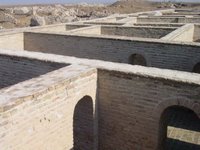

Back in the day, the Euphrates River flowed near the city walls of Ur. According to Muhsen, the city reached a population of somewhere between 250,000 and 500,000. By around 400 B.C. though, the city was deserted. It is thought that the reason for this was the shifting of the Euphrates River. Prior to the shifting of the river, there apparently was grass, trees and a significant amount of vegetation. My, how times have changed.
The most visible dwelling in the area is the Ziggurat. It stands about 70 feet tall. Here are pictures of the Ziggurat from afar and one with me running up its steps:



The Ziggurat was built around 2100 B.C. One thing that I found interesting was that the structure itself is solid. That is, it has no rooms or open areas inside. According to Muhsen, the Ziggurat was built by the Sumerians as a way in which to be closer go the god of the moon. The moon god was suppose to come from the sky and walk down the steps of the Ziggurat to be with the people. The Ziggurat itself was uncovered in the mid-1800's by the British. Apparently, there was at least one more level above the current Ziggurat structure that didn't survive the excavation.
Most of the structures at the city of Ur site are original. Muhsen said that the bricks in the public buildings (like the Ziggurat) are held together with a natural tar-like substance. Because the substance was so expensive back then, private buildings (such as dwellings) often used instead a mud-based substance to hold the bricks together. Here’s a picture of Muhsen explaining some of the details about how the buildings were made:

Below are several things “of note” at the site that I thought were fascinating:
*The site had many examples of ancient cuneiform writing, which according to Muhsen predates hieroglyphics. Here’s a sample:

*Small sea shells from one of the two floods (estimated to have occurred around 4000 B.C. and 2900 B.C.) were all over the place. It was strange to see small sea shells not on the sea shore but on the desert floor instead. :-)
*There were several tombs of kings in which 50 or so servants were buried alive (apparently voluntarily). Here are a number of pictures.




Compare those pictures of tombs with a picture of a tomb of a “common” person, not much higher than mid-thigh:

*The world’s first arch according Muhsen (or perhaps oldest intact?) is located on the site. Here’s a picture:

*There was also a structure the Muhsen said was the first museum. It was a structure that housed a collection of items from earlier times that was put on display for others to see. Here’s a picture of that building:

(the cement on top was put there in the 1990s to preserve the structure in anticipation of a visit from the Pope).
*Finally, we looked at the house of Abraham. The house itself was rebuilt. When they dug up the ruins, all that was left from the site was the foundation and the floors. So, they rebuild the ground floor walls. Apparently, Abraham was fairly well off primarily because of his father’s success as a businessman. According to Muhsen, Abraham’s father earned money by selling idols. That’s ironic. Anyway, Abraham’s house was fairly large. It consisted of more than one level, which wasn’t common for a dwelling back then in that area. The pictures below are of the dwelling, including one with soldiers walking on the walls that formed the basis for the second floor.


Back in the day, the Euphrates River flowed near the city walls of Ur. According to Muhsen, the city reached a population of somewhere between 250,000 and 500,000. By around 400 B.C. though, the city was deserted. It is thought that the reason for this was the shifting of the Euphrates River. Prior to the shifting of the river, there apparently was grass, trees and a significant amount of vegetation. My, how times have changed.
Comments:
<< Home
Thanks for another interesting post. I've never heard of cuneiform writing...until now, that is.
She sells seashells by the sea sand?
I hope you're still singing. Godspeed. Stay safe!
She sells seashells by the sea sand?
I hope you're still singing. Godspeed. Stay safe!
Do you think there is a chance that symbols of the region's ancient pre-religious history could be used to inspire some unified nationalistic feeling among all Iraqis, regardless of their sect? If they were taught the importance to the world of the early history they all share as Iraqis, some of the hostility between Shiites and Sunnis could be dispelled.
Interesting thought. Most Iraqis that I've run into are aware of the history of the region and they are proud of it. With that said, I probably have not communicated with a good cross-section of the population.
Post a Comment
<< Home

